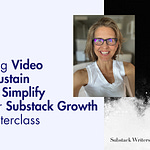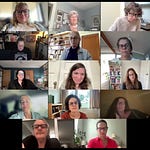Keep it simple. Often, people who teach creative writing overcomplicate it. When it comes to storytelling, plot/narrative arc is everything.
Plot is how we enthrall our subscribers, especially paying subscribers. To enthrall is “to hold spellbound,” i.e., create personal stories that are engrossing, not tedious.
How do we write enthralling—as in I-can’t-stop-reading-this enthralling—personal narratives? How can we make our lives that interesting?
Three ways to find out:
🎥 Watch the 27-minute writing session above ↑
🎧 Listen to the audio version on the Substack Success Podcast →
📖 Read the complete guide below ↓
I’ve taught creative writing in some of the best MFA programs in the country for fifteen years—Northwestern, The University of Iowa, et al. Plot—i.e., the key to telling stories—is one of my favorite things to teach.
Below we cover:
What the best storytellers know
Why your story isn’t interesting: anecdote vs. plot
The key to narratives that keep readers reading
Storytelling worthy of Substack subscribers
Substack Writers at Work Telling Personal Stories Workbook PDF ↓
What the best storytellers know
Great storytelling hinges on five fundamental principles:
1. The best stories have a narrative arc.
2. The protagonist—that's you in a personal essay—must want something.
3. Something sets off a string of causal (not random) events to occur.
4. The protagonist must change through those events.
5. All great stories are about survival, which includes trying and failing to control the world around us.
Why your story isn’t interesting: anecdote vs. plot
E.M. Forster made a crucial distinction between anecdotes and plot in his 1927 craft book, Aspects of the Novel, between anecdote and plot.
Anecdotes are simply events in chronological order: this happened, then this happened, then this happened. There’s no real causal, emotional, or logical structure connecting those events.
Expertly selected events carefully plotted, on the other hand, provide that relationship.
The key to narratives that keep readers reading
Freytag’s Triangle is the foundation of narrative structure. It’s really all you need. Some try to complicate it, but there’s no reason to. Doing Freytag’s Triangle could take an entire career to master. And when you get it right, readers will say, “I couldn’t stop reading.”
The pyramid isn’t an equilateral triangle—this matters. The beginning and end points sit at different altitudes because either the protagonist or the world must change.
The structure flows through several key stages:
1. Background / Once Upon a Time
Stick to the five W's: When, Where, Who, Why, and What were you hoping would happen?
Creative nonfiction writers often want to explain everything, but resist this urge.
2. Inciting Incident
Everything changes.
Life was one way, and suddenly it becomes totally different.
This moment sets off a search because suddenly the protagonist wants something, even if it’s just a glass of water.
3. Rising Action
Creates tension through the protagonist’s want and not getting what we want.
It’s typically a series of obstacles: want, obstacle prevents, revised want, obstacle.
It should make life difficult.
“Nothing interesting happens in heaven, only hell.”
—Charles Baxter
4. Climax
Not a battle scene—it’s a predicament.
It’s a crisis question where the protagonist must choose between two bad things (or sometimes two good things).
The choice must feel impossible, with significant consequences either way.
Falling action/denouement
The fallout/repercussions of the decision.
Resolution
You can “win” at a price or lose.
Paid subscribers, read on for:
Storytelling worthy of Substack subscribers
Substack Writers at Work Telling Personal Stories Workbook PDF ↓











